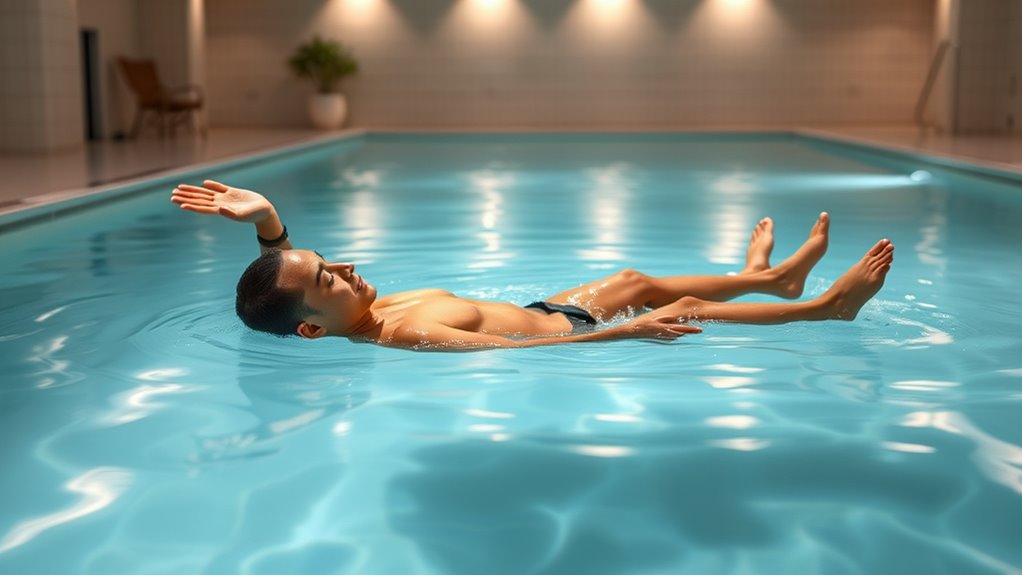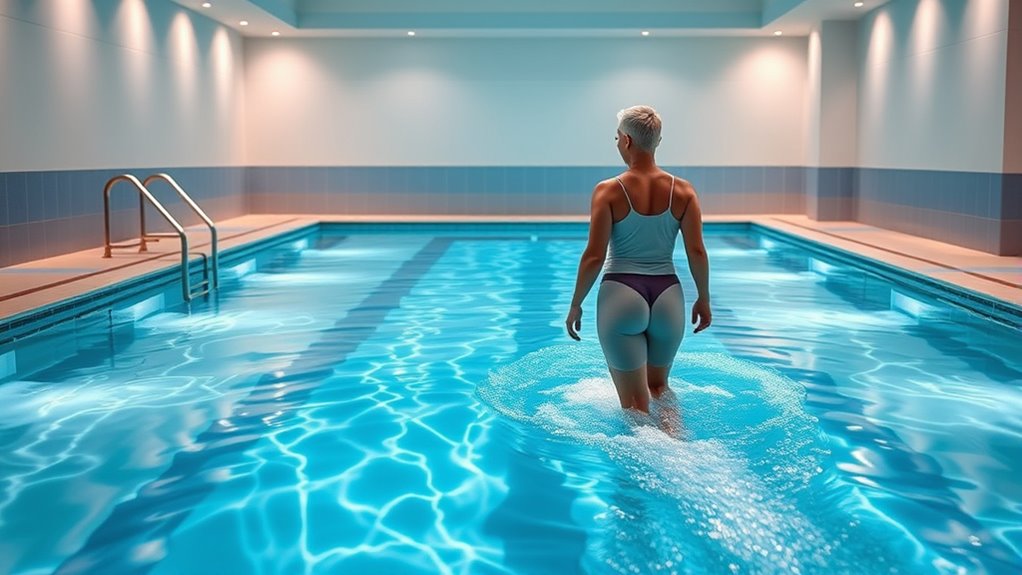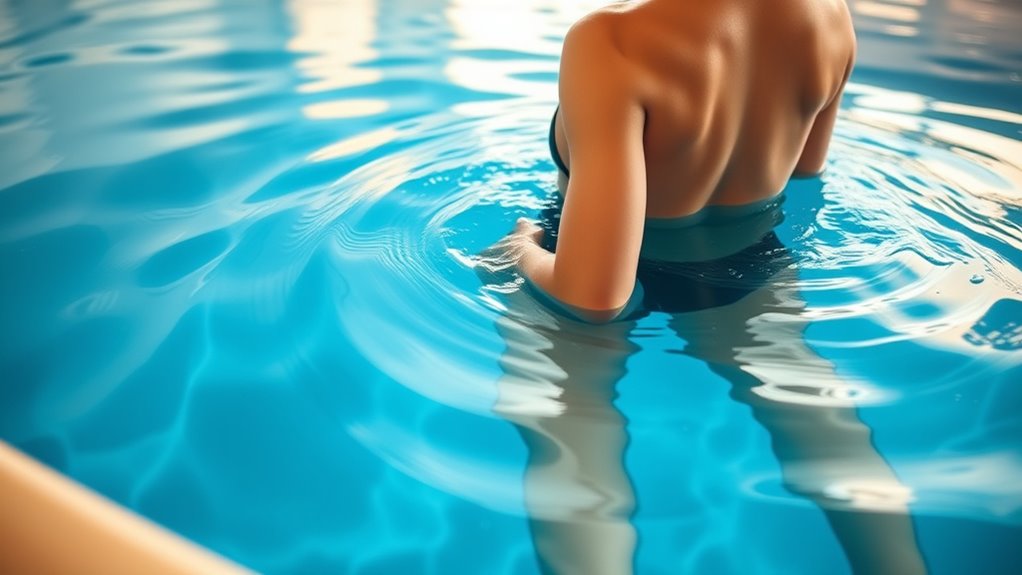Using an endless pool for aqua therapy accelerates injury recovery by providing a safe, low-impact environment with properties like buoyancy, adjustable resistance, and warm water to support gentle movement, reduce swelling, and build strength. Its customizable features let you tailor routines to your injury and progress safely. Many find faster improvements in mobility and pain relief, boosting confidence. Keep exploring to discover how to create effective, personalized aqua therapy sessions that enhance your recovery.
Key Takeaways
- Endless Pools provide a low-impact, controlled environment ideal for gentle movement and early mobilization during injury recovery.
- Adjustable resistance and water temperature support personalized therapy routines, promoting healing and reducing pain.
- Buoyancy reduces joint stress, enabling safe, supervised exercises that improve strength, flexibility, and tissue repair.
- Water properties like warmth and flow accelerate blood flow, decrease inflammation, and facilitate faster tissue healing.
- Private, safe settings enhance motivation, adherence, and monitoring, leading to more effective and efficient injury rehabilitation.
Understanding the Benefits of Aqua Therapy in an Endless Pool

Aqua therapy in an endless pool offers numerous advantages that can accelerate injury recovery. The buoyancy reduces your body weight, easing joint and muscle strain, which allows you to move more freely without pain. This gentle support helps improve your range of motion and flexibility without risking further damage. The warm water promotes blood flow, speeding up healing processes and decreasing inflammation. The controlled environment lets you practice therapeutic exercises safely and comfortably, even with limited mobility. Additionally, the consistent water level and current make it easier to focus on specific movements and rehabilitation goals. Incorporating nutritional support into your recovery plan can further enhance healing and overall well-being. Overall, aqua therapy in an endless pool provides a safe, supportive space to regain strength, restore function, and recover more efficiently from injuries.
Key Features of Endless Pools That Support Injury Recovery

Endless pools are designed with features that make injury recovery more effective and accessible. The adjustable current allows you to control water resistance and speed, enabling gentle, low-impact movements perfect for rehabilitation. The compact size offers a safe environment where you can focus on specific exercises without distractions or risk. The smooth, even water flow minimizes joint strain, helping reduce pain during movement. Many models include temperature controls, so you can maintain a warm, soothing environment that promotes blood flow and relaxes muscles. The clear, unobstructed space makes it easier to monitor your progress and correct your form. These thoughtful features create an ideal setting for gradual, safe recovery, making your aqua therapy sessions both efficient and comfortable. Additionally, understanding projector technology can help you select equipment that provides optimal visual feedback during therapy, enhancing motivation and tracking progress.
Designing a Personalized Aqua Therapy Routine

Creating a personalized aqua therapy routine begins with evaluating your specific injury, fitness level, and recovery goals. Identify which movements or exercises aggravate or alleviate your symptoms. Consult with a healthcare professional to understand any limitations or precautions. Set clear, realistic goals, such as improving range of motion, reducing pain, or rebuilding strength. Tailor your routine by selecting exercises that target your needs, starting with gentle movements and gradually increasing intensity. Incorporate a mix of stretching, strength training, and low-impact cardio to promote balanced recovery. Use appropriate equipment to enhance your exercises and support your progress. Listen to your body during each session, and adjust your routine as you progress. Consistency is key—regular sessions help build confidence and support your healing process effectively.
Types of Injuries That Respond Well to Water-Based Rehabilitation

If you’re recovering from musculoskeletal injuries or have just had surgery, water-based rehab can be especially effective. The buoyancy reduces joint stress and eases pain, helping you regain strength more comfortably. Understanding which injuries respond best can help you get the most out of your aqua therapy sessions. For example, safe sleep guidelines emphasize the importance of proper positioning and environment to ensure safety during recovery and daily routines.
Musculoskeletal Injury Recovery
Water-based rehabilitation is especially effective for recovering from musculoskeletal injuries because the buoyancy and resistance of water help reduce pain and strain while promoting gentle movement. If you’ve experienced sprains, strains, or tendon injuries, aquatic therapy can facilitate safe, controlled exercises that improve flexibility and strength without overloading your joints. Water’s natural resistance challenges your muscles gradually, aiding in rebuilding strength while minimizing the risk of re-injury. Conditions like rotator cuff tears, lower back pain, or knee injuries respond well to this approach because water supports your body and allows you to move through ranges of motion comfortably. By easing pain and encouraging active recovery, water-based therapy accelerates healing and restores function more effectively than land-based exercises alone.
Post-Surgical Rehabilitation
Which types of post-surgical injuries benefit most from water-based rehabilitation? You’ll find that joint replacements, ligament repairs, and tendon surgeries respond well to aqua therapy. Water’s buoyancy reduces joint stress, allowing you to move more freely and with less pain. This enables earlier mobilization, which is key to preventing stiffness and muscle atrophy. Water resistance also helps strengthen muscles without overloading healing tissues. If you’ve had knee or hip replacements, aqua therapy facilitates gentle range-of-motion exercises that accelerate recovery. Similarly, post-rotator cuff repairs or Achilles tendon surgeries benefit from the controlled environment water provides. Overall, water-based rehab is ideal for reducing pain, enhancing mobility, and supporting tissue healing, making it a valuable component of your post-surgical recovery plan.
Safety Considerations and Precautions During Aqua Therapy

Ensuring safety during aqua therapy is essential to prevent injuries and maximize benefits. Always check the water temperature to stay within a safe range, typically between 83°F and 90°F, to avoid overheating or chilling. Use proper equipment, like non-slip mats and secure handrails, to prevent slips and falls. Never push yourself beyond your comfort level or ignore pain signals; listen to your body. It’s important to have a trained professional supervise your sessions, especially if you’re new to aqua therapy or recovering from injury. Stay hydrated and take breaks as needed. Avoid diving or jumping into the pool, and make certain the pool area is free of hazards. Additionally, consider incorporating protective styling benefits into your recovery routine to help maintain your hair health during therapy. These precautions help create a safe environment conducive to effective recovery.
How to Incorporate Aqua Therapy Into Your Overall Recovery Plan

Integrating aqua therapy into your overall recovery plan requires careful planning and coordination with your healthcare team. Start by discussing your goals and current progress with your physical therapist or doctor. They can help you develop a structured schedule that balances land-based exercises with water-based sessions. Be clear about your limitations and listen to your provider’s advice on intensity and duration. Incorporate aqua therapy gradually, increasing activity as your body adapts. Keep detailed records of your sessions and any changes in pain or mobility. Regularly communicate with your healthcare team to adjust your plan as needed. Understanding the benefits of energy-efficient cloud servers can also inspire innovative approaches to your recovery environment, ensuring your therapy sessions are supported by sustainable technology. By aligning aqua therapy with your broader recovery efforts, you maximize healing while minimizing risks. Consistency and teamwork are key to a successful recovery.
Success Stories and Real-Life Outcomes of Using Endless Pools for Healing

Many people have experienced faster recovery times with endless pools, helping them return to daily activities sooner. Personal success stories highlight how tailored aqua therapy can make a real difference. It’s inspiring to see the tangible results others have achieved using this effective healing method. Additionally, incorporating specific aqua therapy techniques can further enhance recovery outcomes.
Accelerated Recovery Timelines
Real-life stories demonstrate how endless pools can substantially speed up injury recovery. Many individuals notice faster progress when incorporating aqua therapy into their routines. The water’s buoyancy reduces joint stress, allowing you to perform movements that might be painful or impossible on land. This support enables earlier and more consistent exercise, which accelerates healing. The adjustable resistance helps tailor workouts to your specific stage of recovery, promoting strength and flexibility without overexertion. As a result, you often experience shorter downtime and quicker return to daily activities. Patients report significant improvements in reduced inflammation, increased circulation, and faster tissue repair. Incorporating aqua therapy can also improve mobility and flexibility, further enhancing recovery outcomes. With consistent use, you can expect to see your recovery timeline shortened, getting you back to full health sooner than traditional rehab methods typically allow.
Personal Success Stories
Numerous individuals have experienced remarkable recoveries by incorporating endless pools into their rehabilitation routines. You might find that patients recovering from knee surgeries or sports injuries report faster progress with water therapy. One person shared how gentle resistance and buoyancy eased their pain and improved mobility more than traditional rehab. Others appreciated the convenience of having a private, consistent environment for daily sessions, which kept their motivation high. Many users noticed reduced swelling, increased strength, and regained confidence sooner than expected. These success stories highlight how endless pools provide a customized, low-impact setting for healing. If you’re seeking a proven way to accelerate recovery, hearing about real-life outcomes can inspire you to explore aqua therapy as a powerful tool in your healing journey.
Frequently Asked Questions
Can Aqua Therapy Be Effective for Chronic, Long-Term Injuries?
Yes, aqua therapy can be effective for chronic, long-term injuries. You benefit from reduced joint stress and gentle resistance, which helps improve mobility, strength, and pain management. By consistently engaging in water-based exercises, you promote healing and prevent further deterioration. The controlled environment allows you to gradually increase activity levels safely, making aqua therapy a valuable part of your long-term injury management plan.
What Is the Ideal Water Temperature for Injury Recovery?
Imagine healing waters that cradle your pain—your ideal temperature is typically between 88-92°F (31-33°C). This warm embrace relaxes muscles and boosts circulation, helping you recover faster. Too hot, and you risk overheating; too cold, and it might slow healing. You want a temperature that feels soothing, like a gentle hug that encourages your body to mend itself. Trust your comfort—it’s the key to effective recovery.
How Long Should Each Aqua Therapy Session Last?
You should aim for each aqua therapy session to last about 20 to 30 minutes. This duration allows you to gain the benefits of water therapy without overexerting yourself or causing fatigue. Start with shorter sessions, especially if you’re new to aqua therapy, and gradually increase the time as your strength and endurance improve. Always listen to your body and consult your healthcare provider for personalized guidance.
Are There Specific Exercises Best Suited for Certain Injuries?
Yes, certain exercises target specific injuries more effectively. For example, gentle water walking helps with joint pain, while resistance exercises strengthen muscles around injured areas. If you have a back injury, focus on core stability activities. Consult your healthcare provider or a physical therapist to customize your routine, making sure you perform exercises safely and effectively. Tailoring your aqua therapy ensures faster recovery and reduces the risk of re-injury.
Can Aqua Therapy Replace Traditional Physical Therapy Methods?
Aqua therapy can complement traditional physical therapy, but it usually can’t fully replace it. You benefit from reduced joint stress and increased mobility in the water, which helps with pain and flexibility. However, certain injuries require targeted exercises and manual interventions only a therapist can provide. To get the best results, combine aqua therapy with your prescribed treatments, ensuring a complete approach tailored to your specific recovery needs.
Conclusion
As you immerse yourself in aqua therapy in your endless pool, you open a gateway to healing that flows like a gentle current, guiding you toward renewed strength. Embrace this liquid sanctuary, where each movement stirs the waters of recovery and propels you forward. With patience and dedication, you’ll find yourself riding the waves of progress, transforming setbacks into comebacks. Let the soothing waters carry you to a brighter, pain-free horizon—you’re closer than you think.









